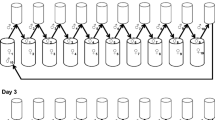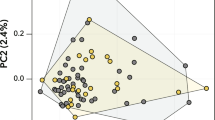Abstract
The Indian subcontinent shows high levels of seasonal weather variation, but the extent to which mating-related traits (mating latency, copulation duration and number of progeny produced) are being affected by such variations in Drosophila species remain poorly understood. In the present study, we analyzed the effects of seasonal change (humidity and temperature) on mating-related traits of Drosophila melanogaster by mimicking natural conditions in the laboratory. The light body color phenotype is collected in large numbers during the rainy season, while the dark phenotype is prevalent in the winter. We found that a short-term stress, in the form of reduced humidity or temperature, causes a strong climatic selection pressure, which leads to assortative mating and longer copulation duration of the dark phenotype. By contrast, the light phenotype shows higher assortative mating and longer copulation duration after short-term high humidity or high temperature stress. Higher assortative mating and increased copulation duration results in high progeny numbers which may be a cause for the high prevalence of the dark phenotype in winter and the light phenotype in the rainy season. Thus, besides plasticity, seasonal changes in mating propensity can be a potential cause of the change in the frequency of the dark and light phenotypes of D. melanogaster during different seasons.


Similar content being viewed by others
References
Aldridge D, Jones CW, Mahar E, Majerus MEN (1993) Differential habitat selection in polymorphic Lepidoptera in the Forest of Dean. Entomol Rec J Var 105:203–214
Bastock M (1956) A genemutation which changes a behavior pattern. Evolution 10:421–439
Beldade P, Brakefield PM, Long AD (2005) Generating phenotypic variation: prospects from ‘evo-devo’ research on Bicyclus anynana wing patterns. Evol Dev 7:101–107
Bijlsma S, Loeschcke V (1997) Environmental stress, adaptation and evolution. Birkhauser, Basel
Brakefield PM (1984) Selection along clines in the ladybird Adalia bipunctata in the Netherlands: a general mating advantage to melanics and its consequences. Heredity 53:37–49
Brakefield PM (1987) Tropical dry and wet season polyphenism in the butterfly Melanitisleda (Satyrinae): phenotypic plasticity and climatic correlates. Biol J Linn Soc 31:175–191
Brakefield PM, Larsen TB (1984) The evolutionary significance of dry and wet season forms in some tropical butterflies. Biol J Linn Soc 22:1–12
Brakefield PM, Reitsma N (1991) Phenotypic plasticity, seasonal climate and the population biology of Bicyclus butterflies (Satyridae) in Malawi. Ecol Entomol 16:291–303
Brakefield PM, Willmer PG (1985) The basis of thermal melanism in the ladybird, Adalia bipunctata: differences in reflectance and thermal properties between morphs. Heredity 54:9–14
Brisson JA, Toni DCD, Duncan I, Templeton AR (2005) Abdominal pigmentation variation in Drosophila polymorpha: geographic variation in the trait, and underlying phylogeography. Evolution 59:1046–1059
Clusella-Trullas S, Van Wyk JH, Spotila JR (2007) Thermal melanism in ectotherms. J Therm Biol 32:235–245
Darwin C (1859) On the origin of species by means of natural selection. John Murray, London
Gilchrist GW, Huey RB (1999) The direct response of Drosophila melanogaster to selection on knockdown temperature. Heredity 83:15–29
Gotthard K, Nylin S (1995) Adaptive plasticity as an adaptation: a selective review of plasticity in animal morphology and life history. Oikos 74:3–17
Hirai Y, Sasaki H, Kimura MT (1999) Copulation duration and its genetic control in Drosophila elegans. Zool Sci 16:211–214
Hoffmann AA, Weeks A (2007) Climatic selection on genes and traits after 100 year old invasion: a critical look at the temperate- tropical clines in Drosophila melanogaster from eastern Australia. Genetica 129:133–147
Hoffmann AA, Anderson A, Hallas R (2002) Opposing clines for high and low temperature resistance in Drosophila melanogaster. Ecol Lett 5:614–618
Huey RB, Crill WD, Kingsolver JG, Weber KE (1992) A method for rapid measurement of heat and cold resistance of small insects. Funct Ecol 6:489–494
Kalmus H (1941) The resistance to desiccation of Drosophila mutants affecting body color. Proc R Soc Lond B 130:185–201
Kari JS, Huey RB (2000) Size and seasonal temperature in free-ranging Drosophila subobscura. J Therm Biol 25:267–272
Kingsolver JG, Wiernasz DC (1991) Seasonal polyphenism in wing-melanin patterns and thermoregulatory adaptation in Pieris butterflies. Am Nat 137:816–830
Krebs RA, Loeschcke V (1994) Effects of exposure to short term heat stress on fittness components in Drosophila melanogaster. J Evol Biol 7:39–49
Kronforst MR, Young LG, Kapan DD, McNeely C, O’Neill RJ, Gilbert LE (2006) Linkage of butterflies mate preference and wing color preference cue at the genomic location of wingless. Proc Natl Acad Sci USA 103:6575–6580
Lee RE, Denlinger DL (1991) Insects at low temperature. Chapman and Hall, New York
Majerus MEN (1990) The importance of form frequency data to ecological genetics. Bull Amat Entomol Soc 49:123–131
Majerus MEN (1994) Ladybirds. Harper Collins, London
Majerus MEN (1998) Melanism: evolution in action. Oxford University Press, Oxford
Majerus MEN, O’ Donald P, Kearns PWE, Ireland H (1986) The genetics and evolution of female choice. Nature 321:64–67
Markow TA, O’Grady P (2006) A guide to species identification and use. Elsevier, USA
Mitchell KA, Sgrò CM, Hoffmann AA (2011) Phenotypic plasticity in upper thermal limits is weakly related to Drosophila species distributions. Funct Ecol 25:661–670
Mizugushi Y, de Almeida JR (1983) Effect of yellow mutant on mating latency and duration of copulation in Drosophila melanogaster. Neotrop Entomol 12:145–150
Neville AC (1975) Biology of the Arthropod cuticle. Springer, New York
O’ Donald P, Muggleton J (1979) Melanic polymorphism in ladybirds maintained by sexual selection. Heredity 43:143–148
Osawa N, Nishida T (1992) Seasonal variation in elytral color polymorphism in Harmonia axyridis (The ladybird beetle): the role of non-random mating. Heredity 69:297–307
Overgaard J, Sorensen JG (2008) Rapid thermal adaptation during field temperature variations in Drosophila melanogaster. Cryobiology 56:159–162
Parkash R, Rajpurohit S, Ramniwas S (2008) Parallel changes in body melanization and desiccation resistance in highland vs. lowland populations of D. melanogaster. J Insect Physiol 54:1050–1056
Parkash R, Singh S, Ramniwas S (2009a) Seasonal changes in humidity level in the tropics impact body color polymorphism and desiccation resistance in Drosophila jambulina—Evidence for melanism-desiccation hypothesis. J Insect Physiol 55:358–368
Parkash R, Sharma V, Kalra B (2009b) Impact of body melanization on desiccation resistance in montane populations on Drosophila melanogaster: analysis of seasonal variation. J Insect Physiol 55:898–908
Parkash R, Sharma V, Kalra B (2010) Correlated changes in thermotolerance traits and body color phenotypes in montane populations of Drosophila melanogaster: analysis of within and between population variations. J Zool 280:49–59
Parkash R, Sharma V, Chahal J, Lambhod C, Kajla B (2011) Impact of body melanization on mating success in Drosophila melanogaster. Entomol Exp Appl 139:47–59
Parkash R, Chahal J, Sharma V, Dev K (2012) Adaptive associations between total body color dimorphism and climatic stress related traits in a stenothermal circumtropical Drosophila species. Insect Sci 19:247–262
Patton ZJ, Krebs RA (2001) The effect of thermal stress on the mating behavior of three Drosophila species. Physiol Biochem Zool 74:783–788
Rhamhalinghan M (1988) Seasonal variations in the color patterns of Coccinella septempunctata L. (Coleoptera: Coccinellidae) in Nilgiri Hills, India. J Bombay Nat Hist Soc 85:551–558
Roskam JC, Brakefield PM (1999) Seasonal polyphenism in Bicyclus (Lepidoptera: Satyridae) butterflies: different climates need different cues. Biol J Linn Soc 66:345–356
Sabath MD, Richmond RC, Torrella RM (1973) Temperature-mediated seasonal color changes in Drosophila putrida. Am Midl Nat 90:509–512
Stoehr AM, Goux H (2008) Seasonal phenotypic plasticity of wing melanization in the cabbage white butterfly, Pieris rapae L. (Lepidoptera: Pieridae). Ecol Entomol 33:137–143
Takahashi A, Takano-Shimizu T (2011) Divergent enhancer haplotype of ebony on inversion in (3R) payne associated with pigmentation variation in a tropical population of Drosophila melanogaster. Mol Ecol 20:4277–4287
Takahashi A, Takahashi K, Ueda R, Takano-Shimizu T (2007) Natural variation of ebony gene controlling thoracic pigmentation in Drosophila melanogaster. Genetics 177:1233–1237
Torres FR, Madi-Ravazzi L (2006) Seasonal variation in natural population of Drosophila spp. (Diptera) in two wood lands in the State of Sao Paulo, Brazil. Itherin Ser Zool 96:437–444
True JR (2003) Insect melanism: the molecules matter. Trends Ecol Evol 18:640–647
Wittkopp PJ, Carroll SB, Kopp A (2003) Evolution in black and white: genetic control of pigment patterns in Drosophila. Trends Genet 19:495–504
Acknowledgments
Kapil Dev and Jyoti Chahal are grateful to Maharshi Dayanand University, Rohtak, for financial assistance in the form of a University Research Scholarship. We are grateful to Mr. Andrew Hamilton for his comments on the language of the MS. We thank two anonymous reviewers for positive and constructive comments on the MS.
Author information
Authors and Affiliations
Corresponding author
About this article
Cite this article
Dev, K., Chahal, J. & Parkash, R. Seasonal variations in the mating-related traits of Drosophila melanogaster . J Ethol 31, 165–174 (2013). https://doi.org/10.1007/s10164-013-0364-2
Received:
Accepted:
Published:
Issue Date:
DOI: https://doi.org/10.1007/s10164-013-0364-2




